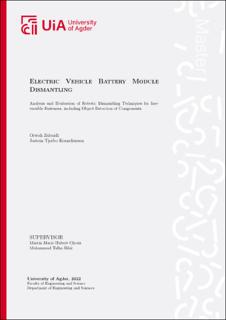| dc.description.abstract | This thesis examines a study of The Litium-Ion Battery (LIB) from a electric vehicle, and
it’s recycling processes. A Battery Module (BM) from the LIB is shredded when considered
an End-Of-Life product, and motivates for automated dismantling concepts to separate the
components to save raw materials.
From State-of-the-art (SoA) research projects and background theory, automatic module dis-
mantling concepts have been evaluated for a Volkswagen E-Golf 2019 battery module. The
presence of irreversible fasteners make the use off destructive dismantling techniques neces-
sary. This study evaluates two different concepts to disconnect laser welds holding together
the compressive plates made of steel. A hydraulic actuated concept is first investigated to
separate the welded compressive plates within the casing. A FEM analysis with different
configurations is performed to evaluate the most effective hydraulic solution when analysing
the Von Mises stress. This solution is further compared with another automatic dismantling
concept, namely milling. For the purpose of an automated milling concept, manipulators
from ABB are assessed and the feasibility is verified based on results from manual milling
operation.
The proposed dismantling operation is made possible by developing a system architecture
combining robotic control and computer vision. Open source software based on Robot Op-
erating System (ROS) and MoveIt connect and control an ABB IRB4400 industrial robot
whereas the computer vision setup involves a cutting edge 3D camera, Zivid, and object
detection algorithm YOLOv5 best suited for this task. Adjustable acquisition settings in
services from Zivid’s ROS driver are tested to accomplish the optimal capture configuration.
Two datasets generated with RoboFlow were exported in the YOLOv5 PyTorch format.
Custom object detection models with annotated components from the BM was trained and
tested with image captures.
All in all, this study demonstrates that the automatic dismantling of battery modules can be
achieved even though they include irreversible fasteners. The proposed methods are verified
on a specific battery module (Egolf 2019) but are flexible enough to be easily extended to a
large variety of EV battery modules. | |
